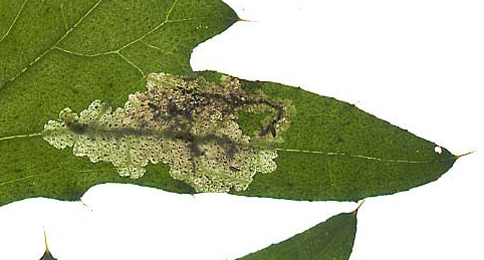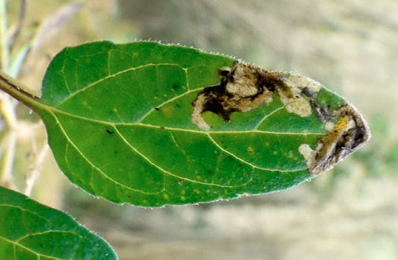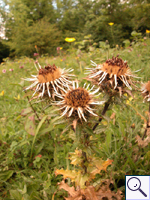|
||||||
|
CARLINA. Carline Thistles [Asteraceae] |
|
|
Two species of Carlina are recorded in Britain, including the native Carline Thistle (C. vulgaris). Five British miners are recorded on Carlina. A key to the European miners recorded on Carlina is provided in Bladmineerders van Europa. |
|
Key for the identification of the known mines of British |
1a > Leaf-miner and case-bearer: The larva lives outside the mine, protected by a case, and feeds on the underlying plant tissues via a hole cut in the epidermis. From that point it eats away as much leaf tissue as it can reach without fully entering the mine. Mine does not contain frass (Coleophora species). The larva forms a case, approximately 11-12 mm long, beneath a thistle leaf, although burdock may sometimes be used. The shape of the ochreous case varies as, when being enlarged, it is elongated first, and the girth increased subsequently. Yellow-brown to light grey tubular silken case with darker length lines. The case is fairly large (up to 17 mm) and very slender. The rear end is three-valved, the mouth angle about 50°. The larva feeds at the underside of the leaf. |
|
Coleophora peribenanderi Toll, 1943 [Lepidoptera: Coleophoridae]. |
1b > Leaf-miner, but not a case-bearer: The mine is brownish and extends along the midrib, sometimes branching. Oviposition on top of the midrib. Immediately after emergence the larva gnaws a cavity in the midrib, and from there an irregular blotch is made adjacent to the midrib. The larva continues living in the midrib that is gradully hollowed out, making from there broad, brownish, full depth excursions in the blade. The mine contains much frass; most of it is concentrated in the area immediately bordering the midrib. Older, no longer occupied parts of the mine often split open. Mines mainly on the lower leaves. The slender larvae move surprisingly fast upon disturbance; when they rest (in daytime) they lie lengthwise in the hollowed midrib. Pupation outside the mine. |
|
Scrobipalpa acuminatella (Sircom, 1850) [Lepidoptera: Incurvariidae]. |
1c >Leaf-miner, but not a case-bearer: Mine linear, whitish, both upper and lower surface. Pupation internal, at the end of the mine with the anterior spiracles projecting through the epidermis (Spencer, 1976: 433). Upper-surface, less often lower-surface corridor. Frass in isolated grains. Pupation within the mine, usually in a lower-surface puparial chamber. A long whitish upper surface corridor, which eventually goes lower surface. |
|
Chromatomyia
horticola (Goureau, 1851) [Diptera: Agromyzidae] |
1d > Leaf-miner, but not a case-bearer: Large, very transparent blotch, with primary and secundary feeding lines. In the centre a concentration of black frass. Mines can coalesce, and then contain several larvae. At the start of the mine, at the leaf underside, a white egg shell. However, the larva can leave its mine and restart elsewehere, therefore mines without an egg shell may occur as well. A white egg is laid at the start of the mine, on the leaf underside. A large clear mine is formed in the centre of the leaf, with a black frass pile. Mines may coalesce and so a mine may contain several larvae (British Leafminers). |
 Mine of Pegomya steini on Cirsium vulgare Image: © Willem Ellis (Bladmineerders van Europa) |
|
Pegomya steini Hendel, 1925 [Diptera: Anthomyiidae]. |
1e >Leaf-miner, but not a case-bearer:Rather narrow corridor, untidy and sometimes branched, starting from the base of the leaf, in particular the midrib. Sides of the corridor irregularly eaten out, not really parallel. Frass mostly present, and then in a central line. The larva is capable of leaving the mine and start a new one elsewhere. These later mines are much broader, and the frass is scattered irregularly.. |
 Mine of Orthochaetes insignis on Prunella vulgaris Image: © Jean-Yves Baugnée (Bladmineerders van Europa) |
|
Orthochaetes insignis (Aube, 1863) [Coleoptera: Curculionidae]. |
| Last updated 01-Jul-2019 Brian Pitkin | ||

